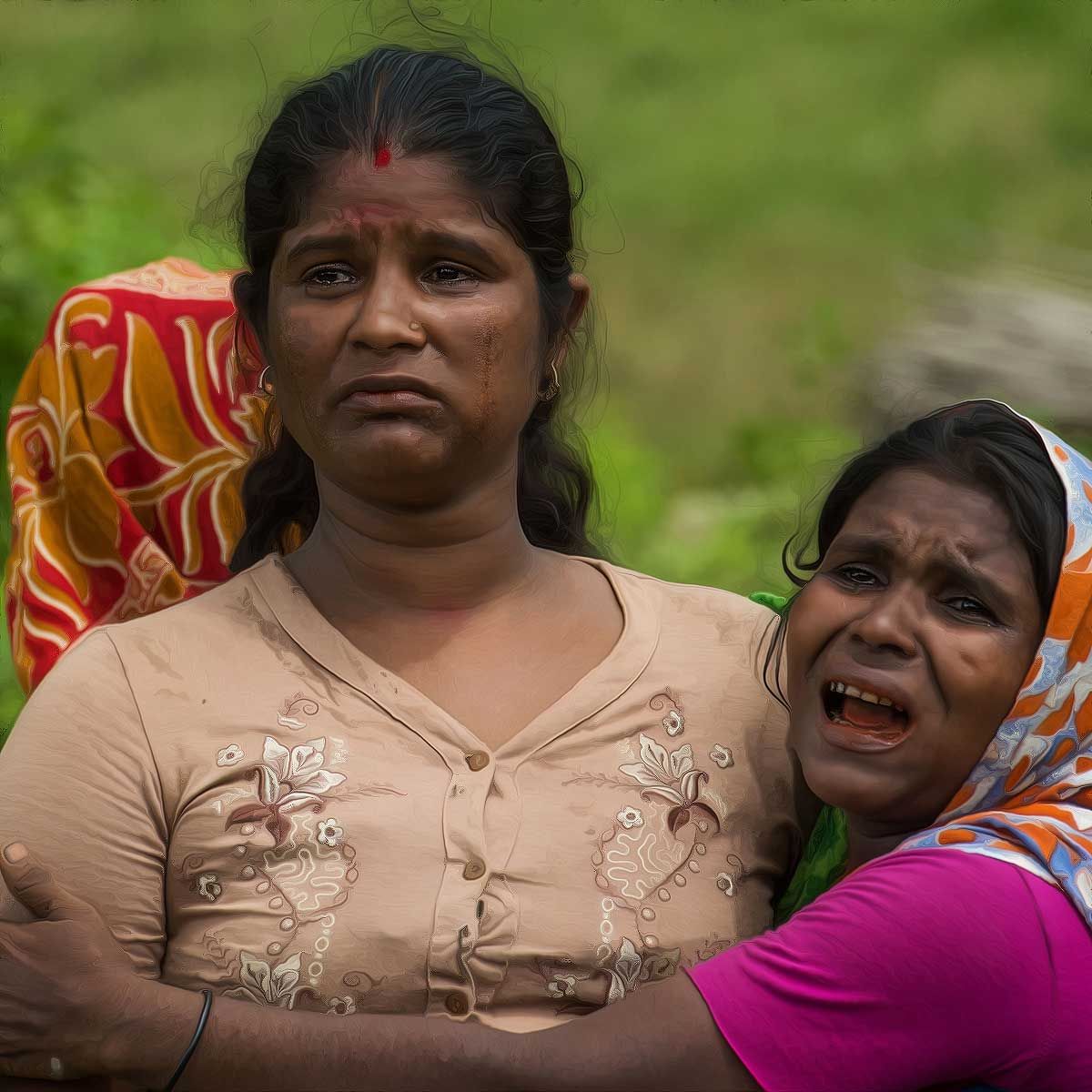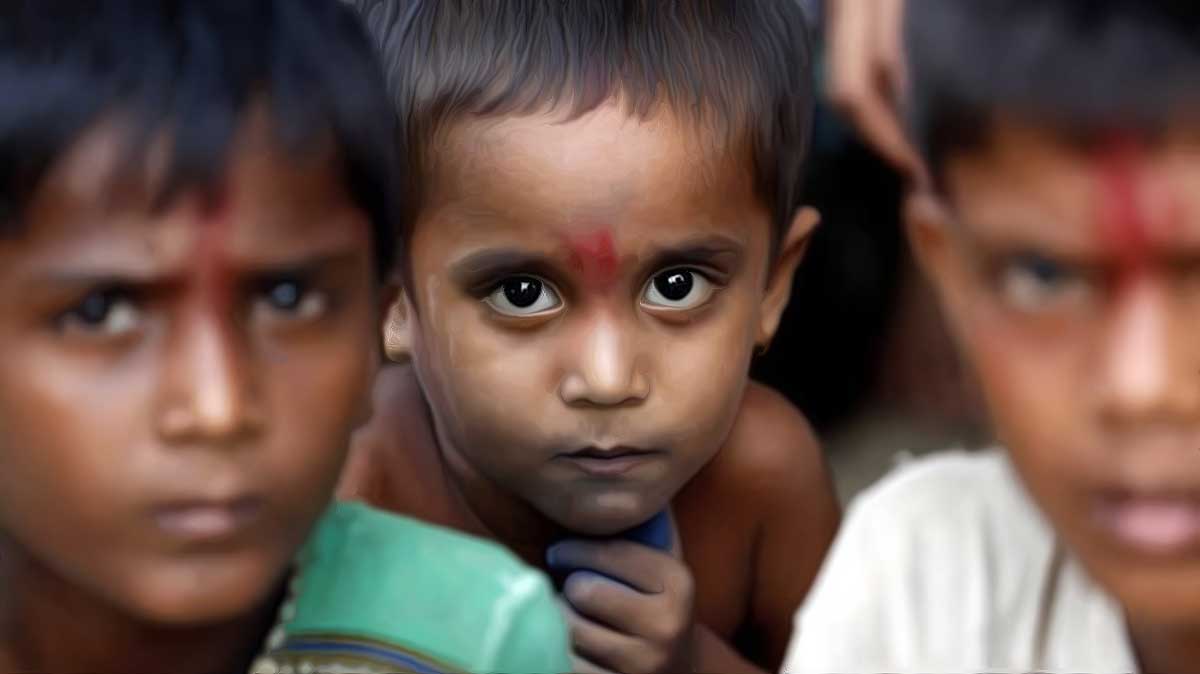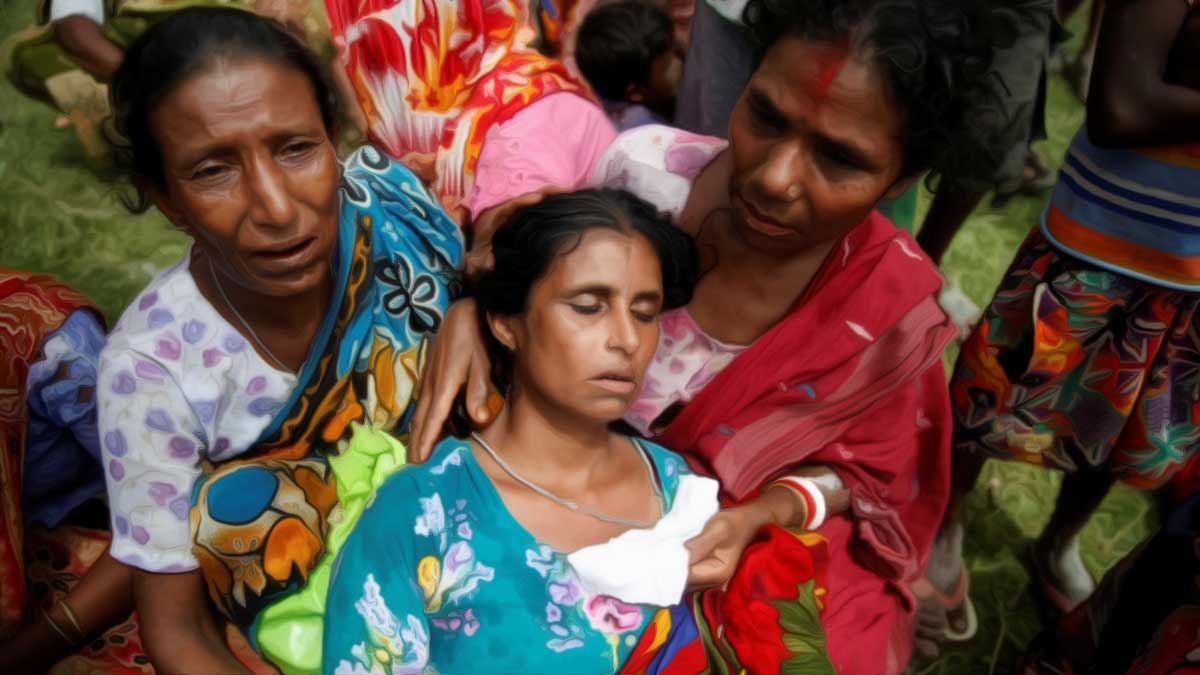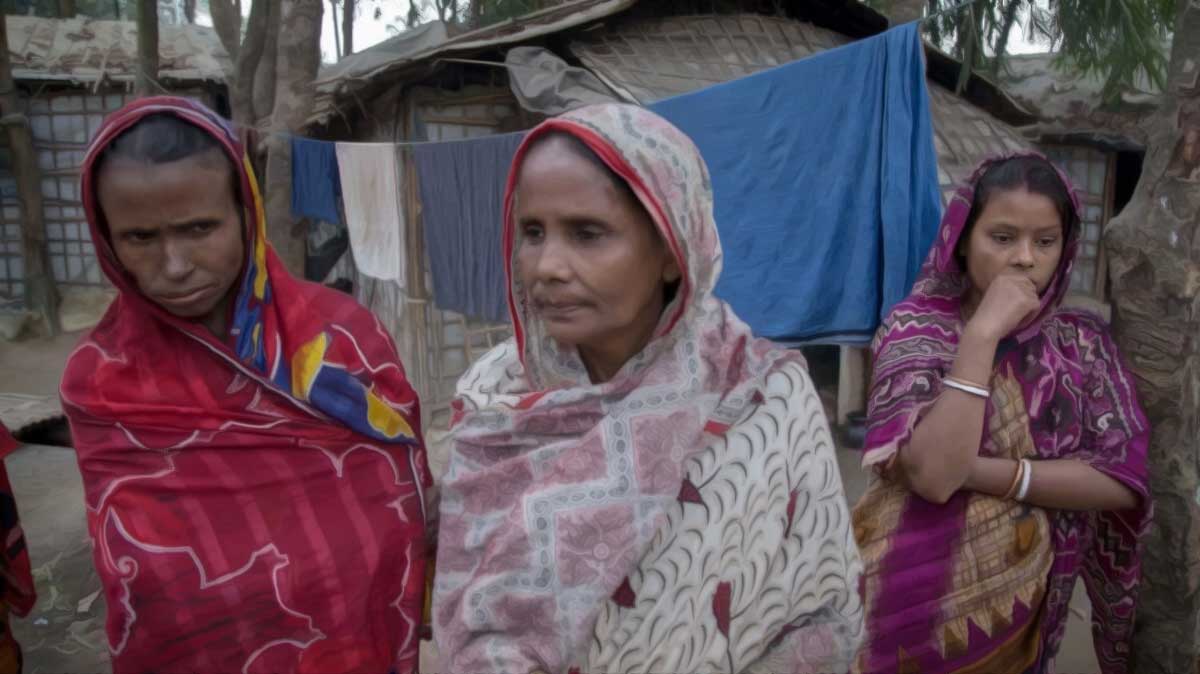MORE COVERAGE
Twitter Coverage
Satyaagrah
Written on
Satyaagrah
Written on
Satyaagrah
Written on
Satyaagrah
Written on
Satyaagrah
Written on
JOIN SATYAAGRAH SOCIAL MEDIA
"Piercing Clarity": UN investigator unveils Rohingya-led massacre of 99 Hindus in Myanmar, a heinous act qualify as an international crime, it's the UN's first recognition of many crimes against Hindus, amplifying global heartbreak and calls for justice

United Nations: A staggering revelation came to light as the UN official tasked with investigating grave human rights violations in Myanmar indicated that the horrifying massacre of 99 Hindus by a Rohingya group might be classified as an international crime.
Nicholas Koumjian, the leader of the Independent Investigative Mechanism for Myanmar (IIMM), was prompted about this gruesome incident from 2017, which had been documented in detail by Amnesty International. Responding with a grave tone, Koumjian expressed, "The incident you're referencing, where almost 100 innocent lives were brutally taken, is undeniably of grave nature and potentially falls under the category of an international crime."
He further clarified that their investigations are not just confined to state actions. Koumjian emphasized, "We are diligently examining actions by non-state entities as well," adding that this specific event was "profoundly serious and unquestionably warrants close attention."
Although Koumjian acknowledged awareness of the aforementioned incident, he maintained a discreet stance, stating, "I won't delve into specifics as we don't disclose details about every incident under our radar for multiple reasons."
Shedding light on the nature of the assault, Amnesty International brought to attention the actions of the (ARSA). This group was responsible for the ruthless killing of 99 Hindus – encompassing women, children, and men. Moreover, several Hindu villagers were taken against their will, deep within Myanmar's Rakhine State in August 2017. At the helm of ARSA is Ataullah abu Ammar Jununi, an individual who traces his origins to Karachi and belongs to the Rohingya community.
In a concerning revelation, the harrowing massacre of Hindus in Myanmar has largely been overshadowed on the international stage, failing to gain the widespread condemnation that other atrocities in the nation have received.
Amnesty International, a global movement for human rights, has been one of the few voices to shed light on this overlooked tragedy. Speaking about the critical importance of addressing these incidents, Tirana Hassan, Amnesty International's Crisis Response Director, commented in 2018: "Our ground investigation offers a crucial perspective on the greatly under-reported human rights violations by ARSA, amidst northern Rakhine State's grim recent past."
In the wake of these and other human rights violations, the UN Human Rights Council instituted the Independent Investigative Mechanism (IIMM) with a defined purpose. This mechanism was envisioned "to amass evidence on the gravest international crimes and breaches of international laws, subsequently preparing dossiers for potential criminal prosecution".
|
However, there have been significant roadblocks to the IIMM's mission. As highlighted by Koumjian, the IIMM faces hindrances and hasn't been permitted to execute investigations directly within Myanmar's boundaries.
Tracing back its inception to the aftermath of the 2017 actions taken by Myanmar against the Rohingya community, Koumjian mentioned that a substantial portion of the IIMM's resources are currently directed towards probing those particular crimes. He further emphasized the IIMM's broader mandate, stating, "Apart from these, our mission also encompasses collecting evidence on heinous crimes perpetrated nationwide. The country's military, in particular, has a prolonged history of crimes against civilians, especially in regions bordering Myanmar," bringing to light an often-neglected narrative of atrocities.
In recent years, Myanmar has witnessed a worrying escalation in the number of violent crimes, especially since the ousting of the civilian-led government under State Counsellor Aung San Suu Kyi in 2019. The grim surge in events, as Koumjian gravely pointed out, is characterized by "brazen acts that include widespread burnings of villages, aerial assaults on civilian regions, and alarming instances of military forces overtaking territories and detaining individuals."
The ARSA's attack on Hindus came during a period marked by the group's aggressive confrontations against Myanmar's security establishments. These acts of provocation precipitated large-scale retaliatory measures by Myanmar's forces. The UN reports indicate a staggering aftermath: around 10,000 Rohingyas lost their lives, with approximately 700,000 being displaced, the majority of whom now find themselves in Bangladeshi refugee camps.
Amnesty International's meticulous documentation of these incidents is a commendable effort to shine a light on these underreported tragedies. Their 2018 study, drawing from a myriad of interviews, cross-border investigations, and forensic photographic evidence, unveiled the chilling details of two major attacks.
|
In the village of Ah Nauk Kha Maung Seik, on August 25, 2017, a heart-wrenching scene unfolded. Fifty-three Hindus, including 14 children younger than eight years, were brutally executed. The report further recounts a chilling act of coercion: "Eight Hindu women and their eight children were spared, but only after being forced by ARSA militants to 'convert' to Islam." Mercifully, these survivors were later safely repatriated to Myanmar.
Adjacent to this, in the village of Ye Bauk Kyar, 46 Hindu inhabitants vanished under mysterious circumstances, presumed to be murdered. The tragic total for that day alone was 99 souls.
The thorough investigative work on the ground is paramount in bringing these overlooked atrocities to the global forefront. It's a clarion call to recognize and address the serious human rights violations by ARSA amidst the haunting shadows of northern Rakhine State’s recent past.
Tirana Hassan, Crisis Response Director at Amnesty International, voiced her sheer disbelief and condemnation of the actions of the Arakan Rohingya Salvation Army (ARSA). She stated, “It’s hard to ignore the sheer brutality of ARSA’s actions, which have left an indelible impression on the survivors we’ve spoken to.” Hassan strongly emphasized the absolute need for accountability for such heinous crimes, drawing parallels with the crimes against humanity carried out by Myanmar’s security forces in northern Rakhine State.
Delving into the specifics of the massacre at Kha Maung Seik, the events unfolded in a dreadfully systematic manner. The morning of 25 August 2017 started with a sudden and unprovoked attack by ARSA on the peaceful Hindu community in the village of Ah Nauk Kha Maung Seik. This village, part of the Kha Maung Seik cluster, lies in the northern regions of Maungdaw Township. It paints a picture of co-existence: Hindu villagers residing alongside their Rohingya neighbors, who are predominantly Muslim, and also with the Rakhine villagers, predominantly Buddhists.
But this harmony was disrupted that fateful morning when armed men, shrouded in black attire, along with local Rohingya villagers in plain clothes, descended upon the village. Their initial actions involved rounding up the Hindu villagers—women, men, and innocent children. These terrified individuals were subjected to robbery, and were then heartlessly bound and blindfolded. They were led to the fringes of their beloved village, a move that hinted at something even more sinister.
Tragically, the worst fears came true. The men were separated from their families and, within a span of a few hours, these ARSA militants ruthlessly executed 53 Hindus in cold blood, beginning with the men. The chilling efficiency and the systematic nature of this massacre highlights a calculated act of violence, ripping apart the very fabric of the community.
Amidst the ominous shadows of the ARSA's malevolent intentions, an even darker tale unfolds—one that pierces the very soul of humanity. The brutal massacre of the Hindus was not the only heinous act they perpetrated. Eight Hindu women, with their innocent children clutched close, were forcibly taken away, separated from the remnants of their families and community. Their lives, already in shambles from the death of their loved ones, faced another horrific twist. These ARSA fighters, in an act of extreme spiritual violence, coerced these already traumatized women to forsake their ancestral faith and “convert” to Islam. One can only begin to fathom the depths of their despair, forced to abandon their roots amidst the pain of loss.
The survivors' ordeal didn’t end with their forced conversion. They were made to escape with their captors to Bangladesh, leaving behind the memories of their homeland stained with the blood of their kin. Yet, a glimmer of hope appeared months later, in October 2017. With the concerted efforts of both Bangladeshi and Myanmar authorities, these shattered souls found their way back home to Myanmar. But what home was left to return to? A home marred by the memories of that gruesome day, with the echoes of their loved ones' last screams still resonating in the air.
A survivor, recalling the harrowing moments, said, "[The men] held knives and long iron rods. They tied our hands behind our backs and blindfolded us." The sheer terror of that moment—bound, blinded, and defenseless, not knowing if the next breath would be their last. The survivor's voice quivered as she continued, "I asked what they were doing. One of them replied, ‘You and Rakhine are the same, you have a different religion, you can’t live here.' He spoke the [Rohingya] language." In their cruel endeavor to strip these people of their belongings, they inflicted pain both physical and emotional. "They asked what belongings we had, then they beat us. Eventually I gave them my gold and money."
The chilling recollections of the survivors serve as heart-wrenching testimonies of the horrors faced by the Hindu community. Their pain, trauma, and the emotional scars they bear are reminders of the price paid for religious intolerance.
Bina Bala's voice trembles as she recounts the horrifying moments she faced during the ARSA massacre. Only 22 years old, she has witnessed atrocities that no human should ever have to experience. With a heavy heart, she spoke to Amnesty International, detailing the bone-chilling terror of that fateful day.
"[The men] held knives and long iron rods. They tied our hands behind our backs and blindfolded us." Bina's voice paints a picture of the paralyzing fear and helplessness she must have felt, unable to see but acutely aware of the looming threat around her. "I asked what they were doing." Her innocence and confusion palpable in these words, trying to make sense of the sudden and brutal upheaval to her previously peaceful life. The cold, heartless response she received revealed the depth of hatred and prejudice that fueled these attackers: "You and Rakhine are the same, you have a different religion, you can't live here." The assailant's words, spoken in the [Rohingya] language, seared into her memory forever.
But their cruelty didn't end with intimidation and threats. They further humiliated their captives by robbing them. Bina, in her soft-spoken manner, described the horror, "They asked what belongings we had, then they beat us. Eventually I gave them my gold and money." The despair in her voice is evident—stripped of her dignity, belongings, and forced to witness unspeakable violence.
 |
Bina's painful account was echoed by other survivors as well. Their testimonies, hauntingly similar, sketch the breadth and depth of the brutality they endured. Each one of them either saw their Hindu relatives being mercilessly killed or heard their agonized screams, an auditory memory that would haunt them for a lifetime.
One such survivor, Raj Kumari, a young woman of just 18 years, choked back tears as she narrated her ordeal: "They slaughtered the men. We were told not to look at them ... They had knives. They also had some spades and iron rods." The horror didn't end there. Hiding amidst shrubs, trying to shield herself from the violent spectacle unfolding before her, Raj Kumari continued, "We hid ourselves in the shrubs there and were able to see a little ... My uncle, my father, my brother – they were all slaughtered."
The chilling stories of Bina Bala, Raj Kumari, and the other survivors shed light on the deep scars left behind by the ARSA massacre. Their stories are a plea for understanding, compassion, and a world where no one has to suffer due to religious differences.
Formila's recollection is a gut-wrenching reminder of the brutalities humans can inflict upon one another. The young woman, barely out of her teens, shared a heartrending account with Amnesty International. She spoke not of witnessing the actual slaughter of the Hindu men but of the haunting aftermath. The sight of fighters returning with their swords and hands stained with fresh blood painted a vivid, horrifying picture. These bloodied weapons were a testament to the ghastly deeds they had just committed. But what Formila witnessed next would remain etched in her mind forever. As she and the other abducted women were led away, a quick turn of her head revealed a nightmare. She recalled, "I saw men holding the heads and hair [of the women] and others were holding knives. And then they cut their throats."
The sheer scale of the massacre is hard to fathom. A detailed list provided to Amnesty International states that the victims from Ah Nauk Kha Maung Seik alone numbered 53 – 20 men, 10 women, and 23 children. Heartbreakingly, 14 of these children were younger than eight. The accounts from various sources, including survivors, witnesses, and Hindu community leaders from both Bangladesh and Myanmar, corroborate this staggering loss of life.
However, the tragedy didn't end there. On the very same day, an entire community in the neighboring village of Ye Bauk Kyar vanished. The ominous cloud of suspicion hung heavily over the ARSA fighters, believed to have killed the 46 Hindu men, women, and children of this village. This brought the total suspected death toll to a harrowing 99 souls.
A morbid discovery was made in late September 2017, revealing the aftermath of the massacre in its full gruesome detail. Four mass graves were unearthed, each holding the remains of the victims from Ah Nauk Kha Maung Seik. 45 bodies were exhumed, their silent testimonies speaking volumes about the cruelty they faced. Yet, the fate of the remaining victims from Ah Nauk Kha Maung Seik, as well as the 46 souls from Ye Bauk Kyar, remains a haunting mystery. Their bodies have yet to be found, leaving a lingering pain and countless unanswered questions for their loved ones.
Amidst the thick shadows of terror, figures of authority and organizations globally have raised their voices against the atrocities committed by ARSA, seeking justice for the innocent lives lost.
Tirana Hassan, known for her dedication to human rights, expressed her abhorrence with profound clarity, “[The] brutal and senseless act [of ARSA]... terrorized [Hindu men, women, and children] before slaughtering them outside their own villages. The perpetrators of this heinous crime must be held to account.” Her words ring out, highlighting the unspeakable horror these innocent individuals faced before meeting their untimely deaths.
But the horrors don't stop there. Amnesty International, an organization renowned for its relentless pursuit of justice and truth, has meticulously documented other instances of ARSA's brutality against different ethnic and religious groups. Notably, just a day after the aforementioned massacre, on 26 August 2017, ARSA's reign of terror continued. Six Hindus – comprising two women, one man, and three innocent children – were killed ruthlessly. Another Hindu woman, bearing witness to this horror, was injured but survived the attack. This chilling event unfolded on the outskirts of Maungdaw town, near the Myo Thu Gyi village.
The records and testimonies echo the same sentiment – that justice must be pursued and the criminals responsible must be held accountable for their inhuman acts.
 |
The heart-wrenching account of Kor Mor La, a 25-year-old survivor, offers a glimpse into the overwhelming terror that gripped innocent civilians during ARSA's relentless assaults. She spoke of the moment she witnessed the death of her husband, Na Ra Yan, 30, and their five-year-old daughter, Shu Nan Daw, right next to her. With her voice quivering, she recounted how the attackers, dressed ominously in black, concealed their identities, revealing only their eyes. Their weapons, long guns and swords, were stark reminders of the merciless intentions they harbored. After being shot, Kor Mor Lar's world blurred, her consciousness waning, with only the haunting memories of the attack etched into her psyche.
However, ARSA's killing spree was not an isolated event. Just a few days earlier, they had initiated a series of ruthless onslaughts on approximately 30 Myanmar security posts on 25 August 2017. This set off a chain reaction of violence, as Myanmar's security forces retaliated with unrestrained ferocity. Amnesty International, along with various other human rights organizations, have meticulously chronicled the myriad of horrors that ensued. This included unspeakable crimes such as killings, sexual violence, tortures, and village burnings – acts so heinous that they qualify as crimes against humanity under international law.
The aftermath of this campaign of terror was devastating, displacing over 693,000 Rohingya people. Seeking refuge and a chance at survival, they migrated to Bangladesh, where they continue to live, trying to rebuild their lives amidst memories of the trauma they endured.
While the mass exodus of the Rohingya community garnered significant international attention, it is essential to recognize that their suffering was not isolated. A considerable number of individuals from various ethnic and religious backgrounds also found themselves ensnared in the vicious spiral of violence that plagued Rakhine State. Many were forcibly uprooted from their places of origin due to the looming threats and the direct consequences of the conflict.
In the aftermath of the violence, a substantial number have bravely ventured back to their homes, attempting to reclaim the fragments of their once-peaceful lives. Yet, some remain in provisional shelters, not by choice, but out of sheer necessity. The reasons are twofold - some face the heartbreak of their homes having been obliterated during the conflict, while others are paralyzed by the fear of potential ARSA onslaughts should they dare to return to their native villages.
|
A Call for Unbiased Scrutiny | The continuous tussle between the Myanmar government and the international community has reached an impasse, with the former accusing global entities of bias. Such allegations, however, lose weight when the same government denies access to the very regions that bear the scars of the conflict – northern Rakhine State. For the world to ascertain the depth and breadth of the atrocities committed by both ARSA and the Myanmar military, it is imperative that neutral human rights investigators are allowed into the region without restrictions. The inclusion of entities like the UN Fact-Finding mission is paramount to ensuring that such investigations are not just thorough, but also devoid of any political influence or agenda. Only then can the world hope to uncover the unvarnished truth of what transpired in Rakhine State.
The Unyielding Quest for Justice | Tirana Hassan, voicing the anguish and outrage shared by many, condemns the two-pronged atrocities witnessed in Rakhine State. On one side, there was ARSA's chilling aggression that affected numerous innocent lives. On the other hand, the Myanmar military's relentless campaign saw the entire Rohingya community at the receiving end of what can only be described as ethnic cleansing. Both actions, rooted in hate and prejudice, must be condemned unequivocally.
It's a grave mistake to get entangled in a tit-for-tat narrative when assessing these heinous acts. The scale or nature of one party's actions does not and should not absolve the other. Both entities have violated human rights to a staggering degree, and this dual culpability cannot be dismissed.
Everyone touched by this tragedy – the survivors who bear physical and psychological scars and the families who mourn the loss of their loved ones – deserve justice. They are entitled to the truth, a chance at reparation, and a commitment from the international community and Myanmar's government that such horror will never be repeated.
This search for accountability, though, is marred by the divisive stance of Myanmar's representatives at international forums. At the recent UN Security Council meeting, the narrative that the international community is biased, choosing to hear "one side" of the story, was reiterated. Such statements, while reflecting a defensive posture, underline the necessity for independent and transparent investigations. Only by acknowledging and addressing violations by all involved parties can there be hope for lasting peace and reconciliation.
Rakhine State, with its mosaic of ethnic and religious communities, witnessed harrowing violence that has raised serious questions about human rights, governance, and international diplomacy. The brutal massacre of Hindus by ARSA militants represents a particularly dark chapter in this ongoing saga.
From the chilling accounts provided, it is apparent that these Hindu victims were targeted not because of any direct involvement in the larger conflict, but because of their religious identity. The calculated manner in which the men were separated and executed, the women and children abducted, and the grim discovery of mass graves encapsulates an orchestrated campaign of terror. This wasn't a random act; it was a deliberate attempt to sow fear and deepen the ethnic and religious divide.
ARSA, while initially seen by some as defenders of the oppressed Rohingya, have shown that their operations, too, are marred by gross human rights violations. The stories of the Hindu survivors painfully illustrate that the group's violent extremism has affected not just the Myanmarese military, but also other innocent civilians.
Yet, while ARSA's acts are horrific, they are but a part of the larger tapestry of violence in Rakhine. The Myanmar military's subsequent campaign against the Rohingya, described by many as "ethnic cleansing," has led to hundreds of thousands being displaced, with innumerable tales of atrocities, from torture and sexual violence to village burnings. It's essential to understand that condemning ARSA’s brutalities doesn't minimize the significance or scale of the military's violations; both are reprehensible and demand international scrutiny.
The role of the international community, especially entities like the United Nations, becomes critical in such scenarios. As the vanguard of global peace and human rights, it is incumbent upon these organizations to ensure that justice is served, not just through words but through concrete actions. The UN Fact-Finding Mission stands as a testament to the global community's commitment to ascertain the truth.
However, the Myanmar government's defensive stance, particularly in international forums, raises concerns. Accusations of the international community being one-sided are not entirely without basis. Global responses to crises often tend to be shaped by geopolitical interests, media narratives, and a range of other non-humanitarian factors. Still, the primary concern remains: to ensure that the truth is unearthed and justice served, unfettered access to the region is indispensable.
In conclusion, the massacre of Hindus by ARSA in Rakhine State stands as a stark reminder of the complexities of ethnic and religious conflicts. It underscores the necessity for holistic solutions that address not only the immediate violence but also the underlying factors that give rise to such horrors. It's not just about assigning blame but about building bridges of understanding and reconciliation. For Rakhine State to find peace, every story must be heard, every act of violence acknowledged, and every effort made to ensure that its diverse communities can once again coexist in harmony. Only through such a comprehensive and empathetic approach can the wounds of Rakhine begin to heal.
 |
 Support Us
Support Us
Satyagraha was born from the heart of our land, with an undying aim to unveil the true essence of Bharat. It seeks to illuminate the hidden tales of our valiant freedom fighters and the rich chronicles that haven't yet sung their complete melody in the mainstream.
While platforms like NDTV and 'The Wire' effortlessly garner funds under the banner of safeguarding democracy, we at Satyagraha walk a different path. Our strength and resonance come from you. In this journey to weave a stronger Bharat, every little contribution amplifies our voice. Let's come together, contribute as you can, and champion the true spirit of our nation.
 |  |  |
| ICICI Bank of Satyaagrah | Razorpay Bank of Satyaagrah | PayPal Bank of Satyaagrah - For International Payments |
If all above doesn't work, then try the LINK below:
Please share the article on other platforms
DISCLAIMER: The author is solely responsible for the views expressed in this article. The author carries the responsibility for citing and/or licensing of images utilized within the text. The website also frequently uses non-commercial images for representational purposes only in line with the article. We are not responsible for the authenticity of such images. If some images have a copyright issue, we request the person/entity to contact us at This email address is being protected from spambots. You need JavaScript enabled to view it. and we will take the necessary actions to resolve the issue.
Related Articles
- Miles2Smiles Foundation seeking donations to help ‘victims’ of the anti-encroachment drive in Jahangirpuri: Previously raised funds for illegal Rohingya Muslim immigrants settling in the country
- Hindu man Chandran aged 50 lynched to death near a temple in Thiruvananthapuram, conspiracy to paint him petty thief hatched by those who killed him: authorities allegedly trying to hush up the incident
- OP Jindal Global University facilitated a hate-mongering ex-prof under the guise of discussing 'History and Politics of the Palestinian Present', who made anti-Hindu remarks, Sameena Dalwai forced students to join the talk and hates ‘Jai Sri Ram’ chant
- Charges framed against Tahir Hussain by Delhi Court for Delhi Anti-Hindu riots 2020: 5 accomplices, active participant, used own house for throwing stone, patrol bombs etc., elaborate preparations to target Hindus
- "Karauli attack on Hindu bike rally was pre-planned on the eve of Hindu New Year, Muslims shut shops entirely and left the locality just before the communal violence started": Another mass Hindu exodus looms large
- White supremacist Law Professor Amy Wax of Penn University displayed her hatred for Bharat by attacking Indian immigrants in the United States and referring to India as a ‘shithole’
- Former Muslim Vice President Hamid Ansari and actress Swara Bhasker share dais with Jamaat-e-Islami linked IAMC which lobbied to get India blacklisted and is infamous for targeting India many times for its sovereign decisions
- West Bengal resident Ankita has filed a complaint with the cybercrime division in the case of sexual harassment of Hindu women, whose pics were pornographically morphed for ‘stud Muslim men’
- Islamist apologists spread fake propaganda to defame Jai Shri Ram. Here are the ‘liberals’ who are ‘ashamed’ over fake news
- Delhi University professor Dr Ratan Lal booked for making vile derogatory statements on Shivling discovered inside disputed Gyanvapi structure, which came to light during the Court-ordered survey
- Online Syndicate of radical Islamists that was targeting people for demanding justice for the slain Hindu Youth is exposed by Social Media user: Kishan Bharwad murder case
- Angered by the rejection of his love proposal a mohammedan Azhar slit the throat of a 23-year-old Hindu girl Anusha in Hanamkonda, Hyderabad: Similarly, Asif Mohammed murdered Prachi Rana in Himachal
- "Devil is no less the devil because he's dressed as an angel": Amidst devout masses and genuine pandits, a disturbing trend of fake pandits has emerged, Sri Ganga Mahasabha caught more than 300 of such confident tricksters wearing saffron & fooling people
- Netflix CEO Reed Hastings expressed his ‘frustration’ over its poor performance in India after shares plummet by 21%, netizens were quick to show the mirror to the streaming platform and blamed its ‘woke bullsh*t’ content
- "Socialism knows every trick in the book, in terms of schemes and fraud": AAP Minister joins controversial event by Buddhist Society of India where 10,000 Hindus were converted to Buddhism, laments how Ambedkar could not convert the entire nation

























